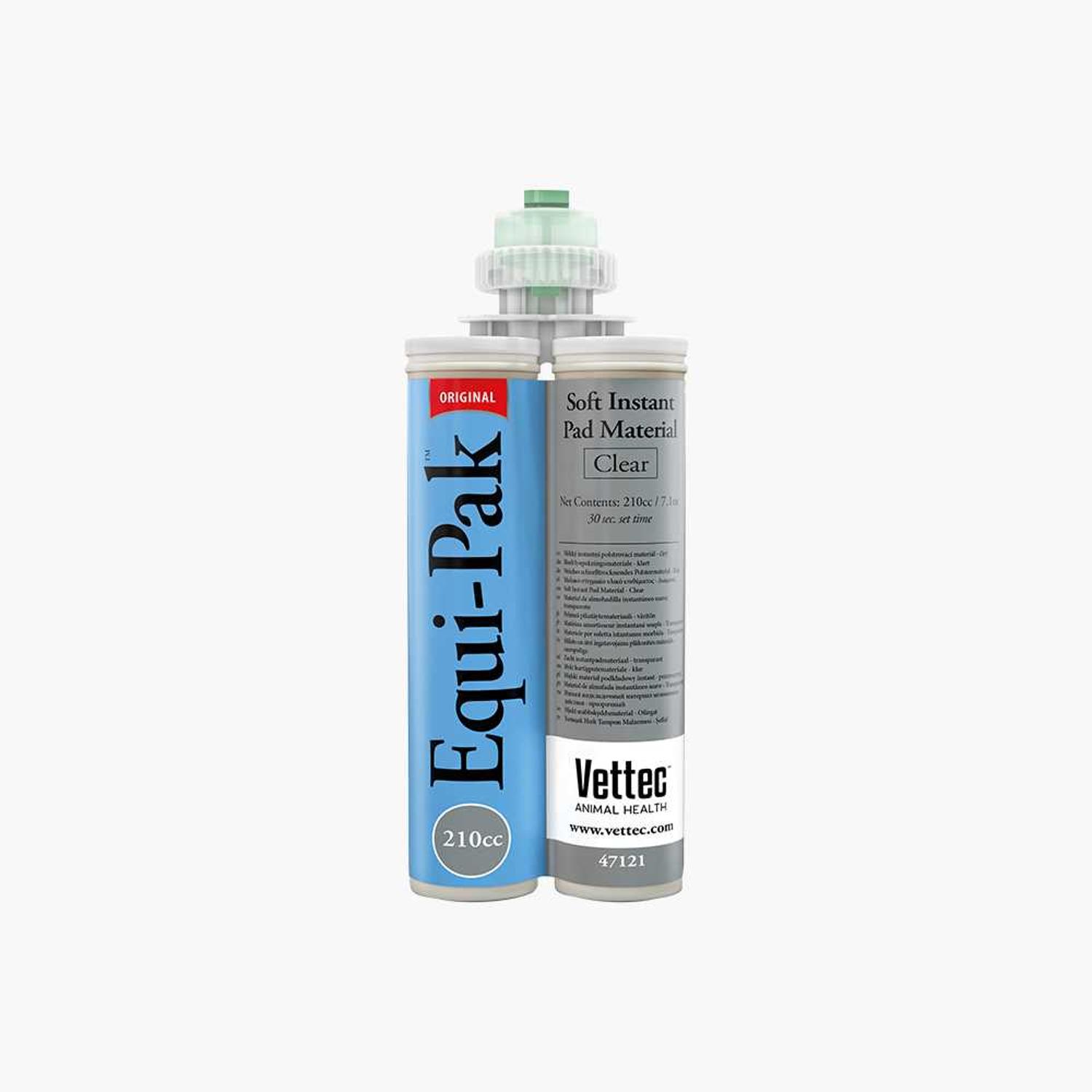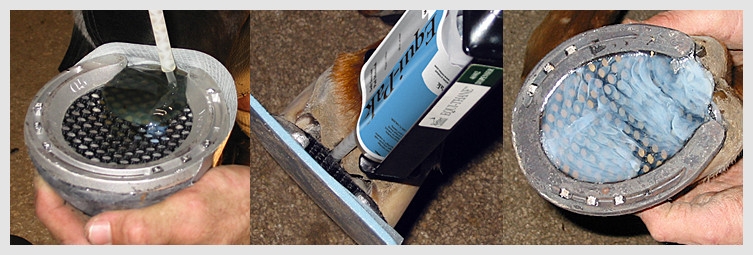
Equi-Pak™ 210cc
Protective, soft padding material that is very suitable in cases of a tipped hoof one or laminitis. Equi-Pak adheres to the sole and frog. You can apply the product in a thin protective layer or fill the hoof completely for full support. The application of a sole is not necessary.
- Color: Blue
- Set time: 30 sec.
- Hardness: 55 shore
- Can be used with or without a pad
- Great for a tilted coffin bone or laminitis

PLEASE NOTE BEFORE APPLYING PRODUCT
- Vettec products are best used between 65° and 85° F (18° to 29° C). Temperature will affect the set time.
See Cold & Hot Conditions below. - Areas of wetness or bleeding should not be covered. Once healed, commence using products.
- Equi-Pak can be applied with the shoe on or off, but will bond to the shoe. A coating of oil or petroleum jelly to the top of shoe will prevent this from occurring. Take care not to get any on the area of the hoof being repaired.
- Product may not bond to hooves that have been heavily treated with products containing: oils, grease, pine tar, etc. In these instances a light denatured alcohol scrub and drying should be performed to ensure adhesion.
- The following procedures are best-accomplished wearing latex or rubber gloves.
- Do not burn or “Hot Shoe” this product.
- Use only Vettec mixing tips.
COLD CONDITIONS (Below 65° F)
- Failure to keep the hooves, shoes, and product warm will dramatically slow the cure time. Example: At 32° F the cure time advances to 1-2 minutes.
- Do not microwave the cartridge or place it in water. Store the cartridges in an insulated “cooler” warmed with microwavable heat pads or 1 to 2 tightly capped gallon jugs filled with hot water.
- In freezing temperatures, 32° F or less, the shoes must be warmed to keep condensation from forming on them and preventing the bond.
HOT CONDITIONS (Above 85° F)
- Product will set very quickly. To slow the set time, if needed store the material in an insulated cooler with 1 or 2 freezer packs.
- NOTE: During hot weather conditions, product may cure at a higher temperature. If applying close to sensitive tissue, product may be applied in layers to reduce heat.
CARTRIDGE PREPARATION
- Open the cartridge. Insert cartridge into dispensing gun.
- Before attaching the mixing tip, equalize the cartridge by squeezing out a small amount to ensure that both sides are dispensing evenly.
- Attach mix tip by pressing tip on to open cartridge. Secure locking collar over the top of the attached mix tip.
- When finished, do not release the pressure with the lever on the back of the dispenser. Remove the mixing tip immediately, discard and apply the cap. Secure the locking collar over the cap to store. The pressure can now be released.
- For additional applications, re-equalize the cartridge and attach a new tip.
HOOF PREPARATION
- Trim and balance the hoof and conservatively pare the sole. Remove any weak or soft material that will exfoliate in the next 2-3 weeks, especially at the white line area.
- Using a hoof knife trim and clean the frog, bars and commissures. Remove all loose sole and dirt with a wire brush.
- Pay special attention to the bars. The bars should not be lying over onto the sole as this could cause a pressure point. If the bars are lying down, trim them back to proper position.
- NOTE: Only if hoof is oily, wipe the affected areas with a cloth moistened with denatured alcohol being careful not to saturate the hoof. Do not use acetone!
- Have all materials ready before proceeding to the next step.
- Holding sole upward dry hoof thoroughly using a heat gun for 30-45 seconds. Do not overheat. Keep heat source approximately 6 inches away from sole. NOTE: All hooves contain natural moisture and must be dried exactly in the manner described above. This step is critical for the product to achieve the appropriate bond to the sole.
APPLICATION PROCEDURE - WITH PADS
- If open at heels: Place mixing tip under the pad at the heel and fill to back of the pad.
- If there is no access: Pre-drill a 5/16 inch hole in the pad near the apex of the frog and nail into position under the shoe. Place mixing tip against the hole and dispense until filled to the back of the pad. Cover the hole with a small piece of duct tape.
- Once set, in approximately 30 seconds, release the hoof. Replace mixing tip and repeat process as necessary.
- Trim any excess material.
APPLICATION PROCEDURE - WITHOUT PADS
- Wire brush the sole and dry thoroughly with a heat gun or hair dryer.
- Cut a piece of Equi-Mesh to the outline of the shoe and place between the hoof and shoe, putting the curved side toward the sole.
- Nail the shoe into position. If the sole is flat, seating out the shoe is advised.
- With the frog turned upward, apply Equi-Pak underneath the web of the shoe and fill in the sole until the desired level is achieved. This is usually to the top of the shoe. NOTE: For added support, load to ground level using a Foam Board.
- Hold the hoof until the Equi-Pak sets, approximately 30 seconds, then release.
APPLICATION PHOTOS
- Support and protection only where you want it. Block out areas where support is not desired such as abscesses and other areas of concern .
- Filled to ground level, Equi-Pak provides full support for weak, thin soled and sensitive feet.
- Equi-Pak provides temporary support and comfort for laminitic and foundered cases until x-rays can be taken.
- Equi-Pak can be used in a thin layer to provide protection against stone bruises in rough riding conditions with or without a pad.
To prevent sore feet or to comfort a sore-footed horse.
For therapeutic or lameness cases you can fill to ground level. For animals in work a pad is strongly recommended.
After the shoe is nailed on, scrub the sole with denatured alcohol and dry thoroughly. Apply Equi-Pak or Equi-Pak|Soft onto the sole, hold the hoof for 30 seconds and release.
NOTE: If wet conditions are expected, tack on a piece of Equi-Mesh as added insurance.
No, the sole is left in great condition. It pares out beautifully.
Yes. Silicone simply transfers shock up the leg while Equi-Pak displaces it.
Yes. After the shoe is nailed on, simply dry the sole and place a foam board over the shoe and dispense the material at the heels, and fill it up to the heels or bulbs.
NOTE: Equi-Pak & Equi-Pak|Soft Hoof Packing will adhere to leather and rubber pads, as well as some types of polyethylene pads.
No, once Equi-Pak & Equi-Pak|Soft sets it stays the same shape until removed.
Yes, a very small amount.
HINT: In extremely hot conditions it's best to cool the material before dispensing, as it may go off hotter than normal.